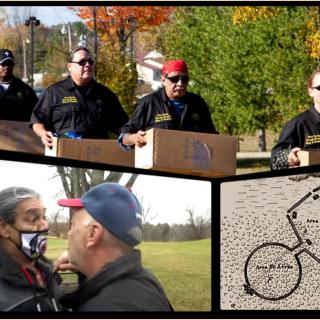Advertisement
Back in September during a roundtable hosted by the Environmental Professionals Network, the executive director of Columbus’s Metro Parks, Tim Moloney, told the audience his “full-time job now is working on RAPID 5 projects”.
A surprising statement for some fans of Columbus’s Metro Parks, which is regarded as a public agency. Surprising because RAPID 5 claims it’s a public/private endeavor – led in part by high-end developers – seeking to connect more people to nature.
The lingering and disturbing question these Metro Parks fans have about RAPID 5 is: Does it have plans for putting ugly condos and soulless retail within the Metro Parks themselves? One RAPID 5 design shows a gondola winding its way through two Metro Parks where passengers can disembark for a brewery that is also within the Metro Park.
Indeed, RAPID 5 has serious designs on all five of Central Ohio’s major north-to-south waterways. All five run through Metro Parks and in some cases multiple Metro Parks: The Big Darby, the Scioto River, the Olentangy River, Alum Creek and the Big Walnut. RAPID stands for “Rivers and Parks Imagination Design” and they have a vision to create America’s largest inter-connected park system.
Don Kloss, a certified naturalist and director of the non-profit Central Ohio Nature, has been keeping a close eye on RAPID 5 since its creation in 2019. Some of its biggest contributors are the City of Columbus, the Urban Land Institute of Columbus, the Mid-Ohio Regional Planning Commission (MORPC), Thrive Companies (a high-end developer which has donated over $1 million to RAPID 5), Advanced Drainage Systems Inc. of Hilliard (its revenue for 2022 over $2 billion), and Continental Real Estate Company (described as a full-service retail and hospitality developer).
Kloss believes Columbus’s newest Metro Park, Quarry Trails in Grandview, is a RAPID 5 prototype considering a $650 million mixed-use development is being built within the Metro Park. He’s also a Metro Parks volunteer but says “before my speaking out I logged hundreds of hours per year in volunteer work. Now I average about 12.”
Kloss says Moloney has too close a relationship with developers such as Thrive Companies, owned by the Wagenbrenner family, which is building the development that is accompanying Quarry Trails. No doubt, the Wagenbrenners are reshaping Columbus – some say to a detriment – with their condos stacked high.
In regards to Moloney saying he is mostly working for RAPID 5, “It begs the question of who at Metro Parks is handling his responsibilities, and how they feel about it,” says Kloss.
“Moloney’s statement is in direct conflict with previous statements of his that Metro Parks and RAPID 5 are not one in the same. It also more than hints that his duties at Metro Parks, for which he is paid a six figure salary ($168,658) are not being handled by him,” says Kloss.
Indeed, RAPID 5 building a brewery within a Metro Park is in direct conflict of its own stated mission: “Columbus and Franklin County Metro Parks (Metro Parks) is a public agency serving the citizens of Central Ohio by providing a regional system of clean, safe, natural area parks. The mission of Metro Parks is to conserve open spaces, while providing places and opportunities that encourage people to discover and experience nature.”
Metro Parks claims to be a public agency, but it is not a true public agency. Its board is not elected, but appointed, and not publicly accountable, says Kloss. Metro Parks is funded through levies but also through things such as rentals of shelter houses and meeting rooms in nature centers, and fees collected from golf courses and summer camps, he adds.
“The Metro Parks’ use of free labor from volunteers is no different from a private company’s use of free labor from college interns. I was told by a source I can’t reveal that Metro Parks management highly encourages volunteers to work shifts at the park’s nature centers as they do as a way to avoid the need to pay full-time and seasonal naturalists to man those centers,” says Kloss.
RAPID 5’s most recent move was to establish a land trust which will allow it to take legal ownership or stewardship over private property at the request of the landowner. RAPID 5 on its website stated, “By establishing a land trust, RAPID 5 can ensure that more land is protected and preserved.”
Kloss believes there has been an internal shift in focus within Columbus’s Metro Parks to appease RAPID 5. From conserving nature and providing public opportunities to experience it, to building new urban parks and adult entertainment centers within the Metro Parks, he says.
Because Metro Parks is now in same treehouse (bed) with RAPID 5, says Kloss, the public needs to be aware that Metro Parks may not be the public agency anymore the public perceives it to be.
“I think people need to be made aware of these things. I get the feeling that, for many people, there is a false attitude of obligation for casting ‘yes’ votes for the Metro Parks levies, such as there is for the public school levies and bond issues,” he says.



